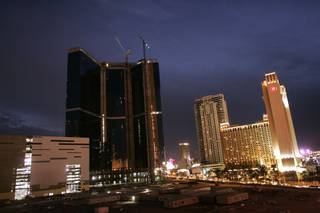Monday, Oct. 12, 2009 | 2 a.m.
Sun Archives
- Fontainebleau judge wants quick sale of bankrupt project (10-2-2009)
- In reversal, Fontainebleau lenders suggest liquidation (9-25-2009)
- Fontainebleau: Bank no longer ‘seeking to destroy’ project (9-17-2009)
- Potential buyer in negotiations for stalled Fontainebleau project (9-15-2009)
- Fontainebleau contractors seek lien claims in state court (9-14-2009)
- Fontainebleau suit against lenders moved from bankruptcy court (8-5-2009)
- Another lawsuit alleges unpaid work at Fontainebleau (7-14-2009)
- Fontainebleau builder says it’s protected from paying severance (7-14-2009)
- Fontainebleau fires back, outlines bank dispute (7-8-2009)
- Fontainebleau developers: Design change could help costs (7-6-2009)
- Court filings shed light on Fontainebleau financing (7-2-2009)
- Practice of building before designs are done hits wall at Fontainebleau (6-28-2009)
- Flood of new hotel rooms dims Vegas outlook for '10 (6-23-2009)
- More subcontractors accuse Fontainebleau of failing to pay for work (6-23-2009)
- Fontainebleau subcontractors want bankruptcy case moved (6-22-09)
- State gaming regulators shied away from policing borrowing (6-21-2009)
- Fontainebleau subcontractors say contractor conflicted (6-19-09)
Of all the buildings under construction nationwide left unfinished because of the recession, the Fontainebleau Las Vegas resort, which analysts say may be nation’s largest and most expensive stalled construction job, might be the poster child for badly timed development.
Fontainebleau is a giant among other unfinished projects in town. Those include Boyd Gaming’s shelved Echelon resort on the Strip and Wyndham’s 19-story Desert Blue time-share building across from the Rio. Unlike Fontainebleau, where workers had finished the exterior and were installing room furnishings in lower floors when work halted this summer, both of these buildings were little more than steel and concrete skeletons when construction halted in August 2008 and February, respectively.
But for all of its new or recent hotel and condominium inventory, Las Vegas isn’t nearly as bad off as South Florida. Nearly all Miami-area condo towers were completed before the economy worsened, but the high-rise boom and bust has left several vacant or near-vacant buildings in its wake.
A few buildings were never built past their foundations, and three Miami-area high-rises — two condo towers with more than 300 units and the second and third towers of a 1,644-unit complex — will be among the last to open in the recession, with lingering questions about how they will be filled.
“If these developers had been one year behind schedule there’d be many more empty buildings,” Miami broker Samir Patel said.
Elsewhere nationwide, many buildings had the relative advantage of never getting off the ground, not being as far along or already being finished when the bottom fell out of the market.
The only other major casino resort awaiting financing to finish construction — Revel, in Atlantic City — is not in as dire straits as Fontainebleau. Work is continuing on the $2 billion project, though interior work was halted to focus on finishing off the resort’s exterior. Revel, privately financed by Morgan Stanley, won’t be opening next year as planned, though owners hope it will open in 2011 with two towers of 1,900 rooms each. The future of Fontainebleau Las Vegas is more uncertain after lenders refused to lend more than $600 million in prearranged financing, throwing the building into bankruptcy. Developers estimate the 63-story Fontainebleau may cost another $1.5 billion to complete on top of the roughly $2 billion already put into the resort.
Several stalled projects elsewhere are remodeling jobs involving existing structures.
Those include the Connell Building in Scranton, Pa., an office building that’s being transformed into a residential building with office and retail space, and the original Filene’s Basement in downtown Boston, which has been closed since 2007 after plans to build a high-rise there stalled.
Others are smaller-scale, mixed-use developments where some buildings were completed and others weren’t. A bank recently agreed to forgive millions in debt on Virginia housing development Belmont Bay and will foreclose on the project, including partially completed condo units.
Though Las Vegas may not lead in unfinished buildings, it tops the nation in major commercial projects that never got past the financing stage before the recession came along. But that’s nothing new: Las Vegas has long attracted speculators with big dreams, little experience and enough millions to secure some land on deposit and develop plans, only for them to evaporate for lack of financing.
During the past real estate boom, multi-billion-dollar resort concepts that were eventually shelved came from bona fide developers with real money. They include Elad, owner of New York’s historic Plaza hotel, which spent $1.2 billion acquiring the site of the imploded New Frontier for a Plaza-themed resort, and James Packer, who has lost millions betting on future growth in Vegas, including a stake in Fontainebleau and the proposed Crown Las Vegas resort.
Fontainebleau secured a $4 billion financing package in June 2007, months after bad mortgages had begun imploding the balance sheets of Wall Street investment banks but well before the mortgage crisis helped take down the economy. In retrospect, the giant buildings for which Las Vegas is known take several years to build — time enough for the economy to turn.
Timing, so the saying goes, is everything.


Join the Discussion:
Check this out for a full explanation of our conversion to the LiveFyre commenting system and instructions on how to sign up for an account.
Full comments policy